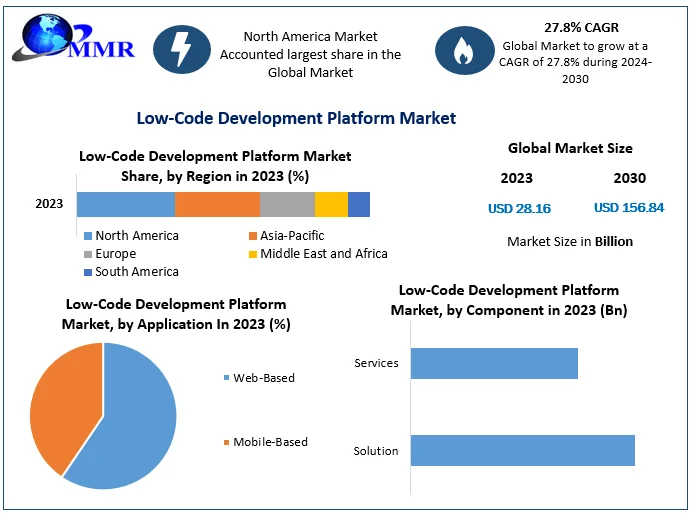Best Suggestions On Picking Low-Code Platform Info
Best Suggestions On Picking Low-Code Platform Info
Blog Article
The Benefits Of Low-Code Programming For Developing Applications As It Pertains To Integration Capabilities
Low-code development of applications offers huge advantages in terms of integration capabilities. They are vital for developing applications that can seamlessly integrate with various systems and services. Here are the key benefits: Pre-built Connectors and APIs:
Connectors that are wide-ranging Low-code platforms have a vast collection of pre-built connectors to popular enterprise system (e.g. ERP, CRM databases and cloud services). The process of integration is simplified.
API Integration: A lot of low-code platforms include integrated API capabilities out of the box that allow developers to connect easily with external services and sources of data.
Easy to use:
Integration via Drag and Drop Integration tasks are typically completed using drag and drop interfaces. Developers and non-developers can set up complex systems that integrate without having to write code.
Visual Workflow Builders : Tools to create workflows and data flow which are visualized help learn and configure integrations in a more intuitive manner.
Standardized Integration Methods:
SOAP and RESTful Service The support for web service standards such as REST and SOAP facilitates easy integration with a variety of different systems.
OData and other Standards Support for standards such as OData facilitates the access and manipulation of data across platforms and applications.
Real-Time Data Synchronization:
Real-Time Integrations: Low-code platforms can handle real-time data transfer between systems and applications. This ensures that data is always up-to-date and consistent across the entire organization.
Event-Driven Architectural: Some platforms come with event-driven architectural designs that allow applications to respond in real-time to events which is essential for dynamic, interactive applications.
Legacy System Integration:
Low-code Platforms: These platforms could be utilized to connect old systems to modern systems. They're a great method to upgrade your IT infrastructure without having to overhaul everything.
Data Migration Tools Built in data-migration tools make it simple to move data from old systems to lower-code applications.
Integration of Third-Party Services:
Cloud Services: Seamless Integration with Cloud Services such as AWS Azure Google Cloud and Google Cloud makes it easy to deploy applications.
Business Applications Integration : Low-code platform can integrate with diverse business applications, including Salesforce.com, SAP, Microsoft Dynamics and others, to enable a seamless workflow across various business processes.
Simplified Data Management:
Data models that are unifying: Certain platforms that offer low-code support for unified data models to simplify data management across different systems.
Data connectors: Data connectors that are preconfigured to give easy access and control to data from multiple sources.
Security and Compliance
Secure Integrations Low-Code platforms are designed to ensure that all integrations conform to the security standards and protocols. This helps protect the data in transit as well as when it is being stored.
Compliance Features - These platforms come with features that ensure the integrations are compliant to regulatory regulations.
Extensibility:
Low-code platforms enable the addition of customized scripts and codes to satisfy more complicated integration needs. This flexibility is provided without compromising user-friendliness.
Plug-in Ecosystems : An eco system of plugins and extensions lets users expand their possibilities of integration. They can include new features when they require.
Overall low-code development platforms provide powerful integration capabilities that make them an ideal instrument for creating integrated and effective applications. They allow you to connect various platforms. They also improve the flow of data. Read the recommended Low-code Platform for application development info for site tips including azure sql server, build a docker container, mobile development platforms, no code platforms, rapid action development, cross platform app dev, application modernisation, azure sql databases, cross platform mobile dev, application modernization software and more.
Low-Code App Development Has Many Benefits In The Area Of Cost-Effectiveness.
Low-code development offers a number of advantages when it comes to cost-effectiveness. Businesses trying to cut costs can take advantage of this option while delivering quality applications. Here are the key benefits: Reduced Development Costs:
A lower code platform makes it less necessary to write long manual code. This means less time and effort on the part of developers while creating applications. It also means lower cost of labor.
Less Developer Resources: Because low-code development is quicker and simpler, less specialized developers are needed. Costs for hiring and staffing can be drastically reduced.
Time to market faster:
Rapid development cycle: Visual development tools and pre-built components provided by platforms that use low-code allow rapid design of applications, which allows companies to get their products on the market quicker. This can translate into more revenue and sales and improved competitive positioning.
Rapid Prototyping: Businesses can build and test prototypes in a very short amount of period of time, which can reduce the time required for the development phase. This allows them to create faster iterations after receiving user feedback.
Low Maintenance Costs
Simpler Maintenance: Low-code platforms, with their standardised components and modular architecture, are easier to maintain. This reduces maintenance and support costs.
Automated Updates. Many low-code platform handle updates and patch automatically. Applications are secure and safe without the need for extensive manual input.
Efficient Resource Utilization:
Platform contributions that are low-code let business users as well as other non-developers participate in the process of creating. This is a way for developers to be more democratic and allows businesses and employees to cooperate, and reduces the dependency on high-paid developers.
Optimized Use Of IT Resources IT teams can focus on strategic projects instead of getting bogged down with mundane work on development, thereby increasing efficiency and productivity overall.
Pricing models that can be scaled:
Subscription pricing: Many low-code platforms provide different subscription pricing options that scale with usage. This enables businesses to make sure that their budget is in line with their actual needs and increase.
Pay-As-You-Go options - Some platforms allow businesses to pay only for the amount they spend. This is particularly beneficial for small or start-up businesses with a limited budget.
Lowering Third-Party Costs of Software:
Low-code platforms usually come with integrated functions that eliminate the need to purchase additional tools or software. This could save you cash on subscriptions and licensing fees.
Pre-Built integrations: These systems and services integrate with other well-known services, reducing the need for custom-developed software, and can save time and money.
Better ROI
Increased Return on Investment: Combining rapid development with lower costs and a quicker speed to market, companies will see a greater ROI on their investments (ROI).
Increased Agility: Businesses are able to quickly adapt to changes in the market and customer needs and ensure that they remain relevant and can capitalize on new opportunities that arise.
Training costs are cheaper:
Low-Code Platforms Have User-Friendly Interfaces. The user-friendly and intuitive interfaces reduce the learning curve of new users. This minimizes the need for intensive training programs.
Accessible Resources: Many low-code platforms offer extensive training materials, tutorials and support for community members, thereby cutting the requirement for formal education and associated costs.
Streamlined Collaboration:
Enhanced Collaboration Tools : The collaboration tools built-in to the software facilitate communication and coordination between the team members. This leads to an efficient development process and lower overhead.
Unified Development Environment (UDE): A single, unifying development environment simplifies workflows, reducing the costs and complexity of managing different tools and platforms.
The efficiency of low-code application development comes from its ability reduce development and maintainance costs, accelerate time to market, optimize resources, and also offer flexible pricing models. These aspects provide significant financial benefits to business and make low-code a compelling option for organizations who want to make the most of their budgets while delivering robust, scalable, high-quality applications. See the recommended my latest blog post on Enterprise application development with Low-code Platform for website tips including microsoft azure sql, microsoft azure sql, no code platforms, rad development, paas service, rapid applications, app modernization, app dev platform, push notifications android, rapid app development and more.
The Advantages Of Low-Code Development For The Development Of Applications With Respect To Restrictions And The Possibility Of Customization
Low-code is a balanced method that permits substantial customization and overcomes issues. Here are some benefits:
Beating Complexity Barriers
Low-code platforms facilitate development by providing pre-built templates and components. This allows rapid deployment and the development of more complex applications.
Guided Workflows - Many platforms provide wizards or workflows that assist developers with difficult procedures. This minimizes the chance of error and ensures the sameness of the process.
Scalability Solutions:
Scalability Built-In Lowcode platforms typically include features to enable the scalable architecture. They enable applications to handle increasing loads without major changes.
Performance Monitoring Tools: Tools for monitoring and optimizing performance are built into the application to ensure that it is efficient, even as it scales.
Security and Compliance
Integrated Security Features : Low codes platforms have security measures built in including encryption and access control based on role. They also run automated compliance checks to identify security issues.
Platforms update frequently their security protocols and ensure compliance with regulatory requirements. This helps keep platforms safe from new threats.
Features for Customization:
Extensibility:
Custom Code Integration: Low-code platforms usually permit the integration of custom code (e.g., JavaScript, Python) which allows developers to extend the functionality beyond the standard offerings.
Developers are able to add customized modules or plugins to address specific business requirements.
APIs and Integration
API Support: A comprehensive support for APIs allows seamless integration with other systems and services, allowing the creation of a wide range of customizations and connections.
Third-Party Services: Low code platforms provide connectors that are designed to work with popular third-party services. This makes it simpler to customize and integrate applications.
Flexible Design for UI/UX
Customizable user interfaces for developers: Developers are able to modify and design user interfaces in order to fulfill specific branding requirements as well as user-friendliness requirements, creating a tailored experience for users.
Responsive design: The ability to tailor applications for various devices and screens is built-in.
Business Logic Customization
Visual Workflow Builders This tool lets developers develop complex processes using little or no programming. They are able to design workflows and business logic using visual.
Conditional Logic and scripting: Platforms permit the application of conditional logic and custom scripting for handling specific business rules.
Data Management
Custom Data Modelling: Developers create custom models that meet particular requirements of the application. They can tailor the handling of data to meet business needs.
Advanced Data Processing: Integration of advanced data processing tools and capabilities permits customization of the way data is processed and utilized within the application.
Balancing limitations with customisation:
Frameworks and Standards
Best Practices for Compliance Low-code platforms promote the use of industry-leading practices and standards, which assists in maintaining high-quality flexible, and secure apps.
Governance Frameworks - Built-in governance frameworks ensure that customisations do not compromise security, integrity or adherence.
Feedback and Iterative Design
Rapid prototyping: Developers are able to quickly test their customizations and prototypes in response to feedback from users, and improve the app according to their requirements.
Low-code platforms are designed to enable continuous enhancement. This permits for modifications and improvements as requirements for business change.
Empowering Users:
Low-code platforms allow citizen developers to develop through letting non-developers by using intuitive interfaces to modify applications, they broaden the pool of developers who can improve and customize apps.
Training and Support: A lot of platforms provide comprehensive training and support to help users make efficient modifications without compromising the application's stability or performance.
Overall, the Low-code app creation provides a framework that is sturdy and adaptable enough to handle restrictions while allowing plenty of customisation. This balance allows businesses to develop and maintain functional applications designed to meet their requirements while ensuring high standards of quality, security and scaling.